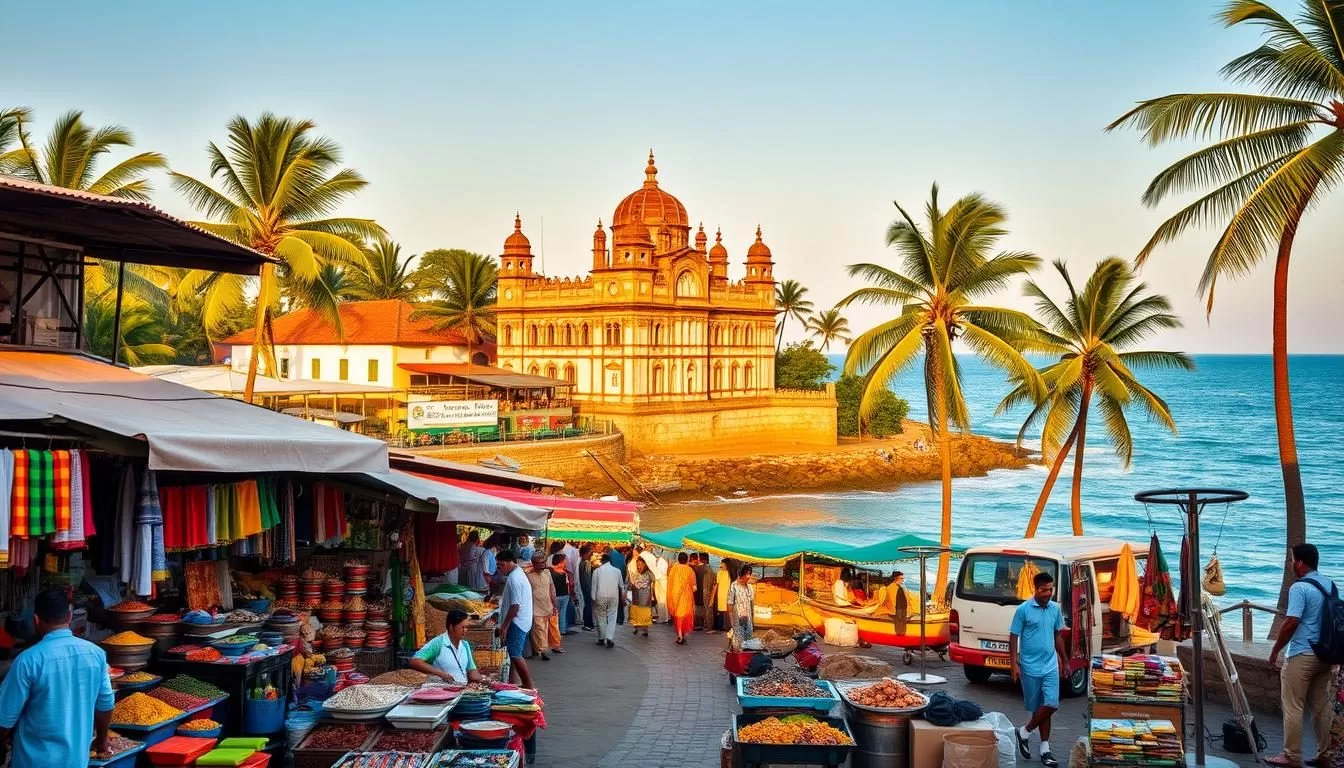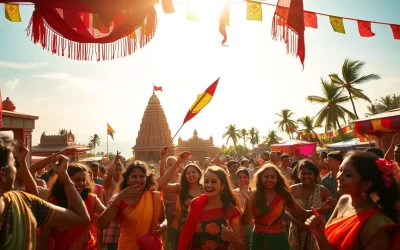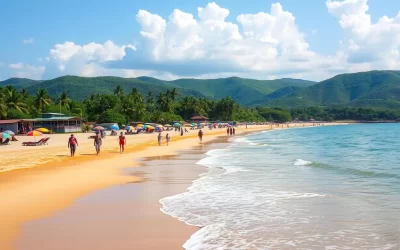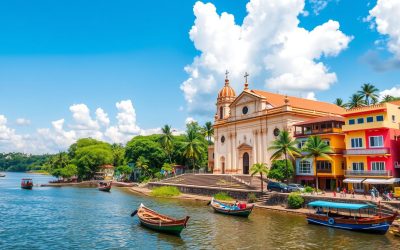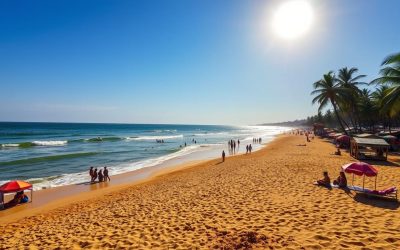✓ Accommodations✓ Flights✓ Rental Cars✓ Tours & Activities
As you explore the coastal paradise of Goa, you’ll uncover a rich tapestry of languages and cultures shaped by centuries of history.
The official language of Goa is Konkani, recognized by the Official Language Act of 1987. However, the state’s linguistic landscape is diverse, with significant populations speaking Marathi, Hindi, English, and Portuguese.
Understanding the languages spoken in Goa enhances your travel experience, allowing for deeper connections with locals and a greater appreciation of the region’s heritage.
With a history of over 450 years of Portuguese colonial rule, Goa’s cultural identity is unique, making it a fascinating place to visit.
The Linguistic Landscape of Goa
You will discover that Goa’s language profile is a unique blend of various cultural and historical factors. The state’s linguistic evolution has been shaped by its 450-year history under Portuguese colonial rule, creating distinct language patterns compared to neighboring Indian states.
A Melting Pot of Languages and Cultures
Goa is a melting pot of languages, with influences from various cultures and empires. The pre-colonial linguistic landscape included strong influences from the Kadamba and Vijayanagara empires, contributing to the development of early Konkani and the presence of Kannada in the region.
- The state has a rich cultural heritage, with multiple languages coexisting.
- The linguistic diversity is a result of historical influences and cultural exchanges.
Historical Influences on Goan Languages
During the colonial days, Portuguese was used in verbal and official communications, and everyone had to learn it. However, both Konkani and Marathi survived as parents secretly taught their children at home. After Goa’s liberation in 1961, a conscious effort to revitalize Konkani emerged, leading to its recognition as the official state language in 1987.
The maritime history of Goa as a major trading port created additional linguistic influences through contact with Arab, Persian, and European merchants over centuries.
Konkani: The Official Language of Goa
As you explore the linguistic landscape of Goa, you’ll discover that Konkani holds a special place as the official language. This language is not just a means of communication but a vital part of Goan identity.
History and Development of Konkani
The history of Konkani is complex, with influences from various languages due to Goa’s strategic location and historical trade routes. Konkani has evolved over time, absorbing elements from different cultures, making it a unique language.
Konkani Dialects in Goa
In Goa, Konkani is spoken in various dialects, reflecting the state’s cultural diversity. These dialects are influenced by geographical locations and community backgrounds, enriching the linguistic tapestry of the region.

Scripts Used for Writing Konkani
Konkani is written in multiple scripts, showcasing its adaptability. The Devanagari script is the officially recognized standard for Konkani in Goa, used in government documents and education. Other scripts like Roman, Kannada, Malayalam, and Perso-Arabic are also used, reflecting the language’s spread across different cultural regions.
The use of different scripts for Konkani, such as Romi Konkani among Goan Christians, highlights the language’s versatility and its ability to thrive in various cultural contexts.
Marathi in Goa: The Second Most Popular Language
The state of Goa acknowledges Marathi as a prominent language, second only to Konkani. While Konkani is the official language, Marathi is widely used in official communications, particularly in regions bordering Maharashtra.
Relationship Between Konkani and Marathi
Konkani and Marathi share a complex relationship, with some considering Konkani a dialect of Marathi. However, the distinct cultural identity of Goa has fostered a unique linguistic heritage. The similarity between the two languages is undeniable, yet Konkani has its own distinct grammar and vocabulary.
The Konkani-Marathi Language Conflict
The Konkani-Marathi language conflict represents a significant cultural and political issue in post-liberation Goa. The dispute centered on whether Goa should maintain a distinct cultural identity or be integrated with Maharashtra. The Official Language Act of 1987 established Konkani as Goa’s official language while providing special status to Marathi, representing a compromise solution.
| Language | Status in Goa | Usage |
|---|---|---|
| Konkani | Official Language | Widely spoken and used in official communications |
| Marathi | Special Status | Used in official communications, particularly in North Goa |
Portuguese Influence on Goan Languages
You might be surprised to learn how the Portuguese language has shaped the way people communicate in Goa. The colonial legacy is still visible in various aspects of Goan culture.
Colonial Legacy in Linguistics
The Portuguese language was imposed on Goa during the colonial period, leaving a lasting impact on the local languages. Many Goan surnames and place names are of Portuguese origin, reflecting the historical influence of Portuguese rule. Konkani, the official language of Goa, has borrowed words and phrases from Portuguese, especially in everyday conversations.
Current Status of Portuguese in Goa
Although Portuguese is no longer widely spoken in daily life, there is a renewed interest in the language. Many schools now offer Portuguese as a third language, and cultural organizations are promoting its use. The Fundação Oriente and other Indo-Portuguese cultural organizations actively promote language classes and cultural exchanges.

| Aspect | Portuguese Influence | Current Status |
|---|---|---|
| Language | Many loanwords in Konkani | Taught in schools as third language |
| Culture | Visible in architecture, cuisine, music | Promoted by cultural organizations |
| Surnames | Many Goan surnames are Portuguese | Still used by Goan families |
As a tourist, you can experience this unique blend of cultures during your visit to Goa. The languages spoken in Goa reflect its rich history and cultural diversity.
Hindi and English: Bridging Communication Gaps
In Goa, the use of Hindi and English facilitates communication between locals and tourists, enhancing the overall travel experience. This linguistic diversity is particularly evident in the state’s tourism and business sectors.
Hindi Usage in Goan Society
Hindi is widely understood in Goa, particularly among the younger population and those in the service industry. Many locals use Hindi to communicate with tourists from other parts of India. As a result, you can easily navigate the state using Hindi, especially in areas frequented by tourists.
English as the Language of Tourism and Business
English is the primary language used in Goa’s tourism industry, enabling seamless communication with international visitors. Many businesses, including hotels and tourist facilities, operate in English, making Goa an attractive destination for foreign tourists. The prevalence of English signage and informational materials throughout tourist areas enhances the overall experience for visitors, making it easier for them to explore the state.
Other Languages Spoken in Goa
While Konkani and Marathi are predominant, other languages also have a significant presence in Goa, contributing to the state’s rich linguistic diversity.
Kannada, Urdu, and Regional Influences
Goa is home to various linguistic communities, with Kannada and Urdu being notable. According to the 2011 census, Kannada is spoken by 5.5% of the population, while Urdu is spoken by 4%. These languages reflect the historical and cultural exchanges that have shaped Goa’s identity.
Language Demographics in Goa
The linguistic demographics of Goa reveal a complex tapestry. Konkani remains the dominant language, spoken by 57% of the population, followed by Marathi at 23%. The remaining percentage is distributed among other languages, including Hindi, Kannada, and Urdu. This diversity is a testament to the cultural richness of the region, making Goa a unique place stay for people from various linguistic backgrounds.
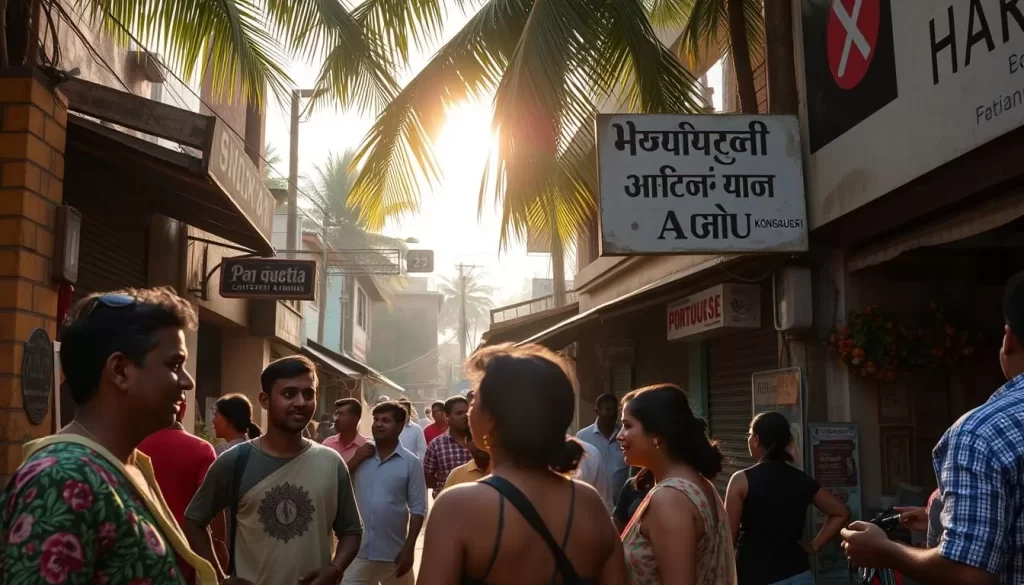
Goa, India: Official and Widely Spoken Languages – A Statistical Overview
The linguistic identity of Goa is shaped by its historical, cultural, and geographical contexts. Goa’s language landscape is a complex tapestry woven from its past and present.
Language Distribution According to Census Data
Census data provides valuable insights into the languages spoken in Goa. Between 1961 and 2011, significant shifts were observed in the linguistic demographics of Goa.
| Language | 1961 (%) | 2011 (%) |
|---|---|---|
| Konkani | 50% | 57% |
| Portuguese | Official Language | <1% |
| English | N/A | Steady Growth |
This data reflects the changing linguistic landscape, influenced by historical events and culture.
Language Trends and Changes Over Time
Over time, Goa’s linguistic landscape has evolved significantly. The influence of migration and globalization has introduced new languages, while traditional languages continue to play a vital role.
- Konkani has maintained its position as the predominant language.
- English has gained prominence, especially in urban areas and among the younger population.
- Migration has introduced languages like Bengali and Nepali.
Understanding these trends is crucial for appreciating the dynamic nature of Goa’s linguistic language and culture.
Essential Konkani Phrases for Travelers
When traveling to Goa, learning a few essential Konkani phrases can greatly enhance your experience. Konkani, the official language of Goa, is a key to unlocking the local culture and connecting with the community.
Everyday Greetings and Conversations
Mastering basic greetings and expressions can make a significant difference in your interactions with locals. While the specific phrases are not provided, understanding the importance of greetings is crucial. You can start with simple expressions to show respect and friendliness.
Phrases for Getting Around
To navigate Goa effectively, knowing phrases related to directions and transportation is helpful. Although specific phrases are not listed under this category, you can use the Konkani phrases for directions and questions like “where is?” to get around.
Food and Shopping Terminology
Understanding food-related terms can enhance your culinary adventures. You can use phrases like “Maka bhook lagleah” (I am hungry) and “Maka taan lagleah” (I am thirsty) to communicate your needs. Other useful terms include “Oodok” (water), “Maka tik naka” (not spicy), and “Jevon borem” (the food is good). For shopping, you can use phrases like “Kitlem?” (how much?) and “Ekdom mar-rog!” (too expensive!). Some key phrases to remember include:
- “Maka khaunk ‘snacks’ khuim meltolem?” (Where can I get some snacks?)
- “Tumi kaju bhieo viktaat?” (Do you sell cashew nuts?)
- “Tu credit card ghetam?” (Do you take credit card?)
These phrases will help you navigate local markets and restaurants, making your experience more enjoyable.
Cultural Significance of Language in Goan Society
Language plays a pivotal role in shaping the cultural identity of Goa, a state known for its diverse linguistic landscape. The significance of language in Goan culture is evident in various aspects of societal life, from festivals to everyday conversations.
Language and Identity in Goa
In Goa, language is closely tied to the locals’ sense of identity. Konkani, being the official language, holds a special place in the hearts of the Goan people. It is not just a means of communication but a symbol of cultural heritage. The locals take pride in their language, and it is often at the forefront of cultural celebrations.
Language in Festivals and Traditions
Goan festivals and traditions are vibrant expressions of the state’s linguistic diversity. For instance, the Konkani Lokotsav, although held outside Goa, is a significant event that celebrates Konkani language and culture through various literary and cultural programs. Similarly, local festivals like Carnival and Feast of St. Francis Xavier feature Konkani prominently, showcasing its importance in Catholic celebrations.
The table below highlights some key aspects of language in Goan festivals and traditions:
| Festival/Tradition | Language(s) Used | Cultural Significance |
|---|---|---|
| Carnival | Konkani | Reflects Catholic heritage |
| Feast of St. Francis Xavier | Konkani, English | Celebrates the saint’s significance |
| Konkani Dis (Konkani Day) | Konkani | Commemorates official recognition |
These celebrations not only showcase the linguistic richness of Goa but also underscore the importance of language in preserving cultural heritage. As you explore Goa, you will find that language plays a vital role in shaping the state’s identity and cultural practices, including its food, traditions, and everyday life.
The “Susegaad” Way of Life: Understanding Goan Slang
Understanding Goan slang is key to embracing the ‘susegaad’ way of life, a unique cultural experience. The term ‘susegaad’ itself reflects a laid-back attitude towards life, characteristic of the Goan culture.
Popular Goan Expressions and Their Meanings
Goan slang is rich with expressions that reflect the local lifestyle. For instance, conversations often value quality over speed, mirroring the unhurried rhythm of traditional Goan speech. You might hear references to natural elements like the sea (doria) or coconut palms (madi), highlighting the close relationship between language and environment.
How Language Reflects the Goan Lifestyle
The prevalence of food-related vocabulary in everyday Konkani conversation underscores the importance of culinary traditions in Goan identity. Moreover, code-switching between languages based on context demonstrates the adaptable nature of Goan identity. Traditional greetings like “Dev borem korum” reflect the influence of spiritual values in daily interactions, giving you a glimpse into the Goan way of life over time.

Tips for Language Navigation in Goa
To make the most of your Goa travel, understanding local language nuances is crucial. Having a working knowledge of the local tongue will not only bring a smile to the faces of the locals but also make them friendlier and potentially offer you better deals at your place of stay, including hotels.
Language Etiquette for Tourists
When interacting with locals, using basic phrases like greetings and expressions of gratitude can go a long way. It’s about showing respect for their culture, which is reflected in their language. Many upscale hotels in Goa also provide complimentary language cards to help guests navigate local interactions more confidently.
Resources for Learning Basic Konkani
For those looking to learn more than just common phrases, there are several resources available. You can start with digital resources like the “Learn Konkani” app or “Konkani Dictionary” for basic vocabulary and pronunciation guides. Additionally, the Goa Konkani Akademi publishes useful language materials, and YouTube features numerous Konkani language tutorials created by locals.
Conclusion
Goa’s unique blend of languages is a key aspect of its identity, shaping your travel experience in profound ways. As you’ve seen, the state’s linguistic landscape is a fascinating tapestry that enhances your stay, whether you’re staying in luxury hotels, beachside villas, or family guesthouses during your days in Goa.
Understanding the historical significance of Konkani and engaging with local languages adds a meaningful dimension to your experience, from ordering local food specialties to navigating markets and understanding cultural traditions. Even a small effort to learn basic Konkani phrases can transform your interactions with locals.
Whether you’re looking for the best hotels or exploring the local culture, Goa’s multilingual character reflects its rich history and continues to shape its distinctive cultural identity.
The above is subject to change.
Check back often to TRAVEL.COM for the latest travel tips and deals.
